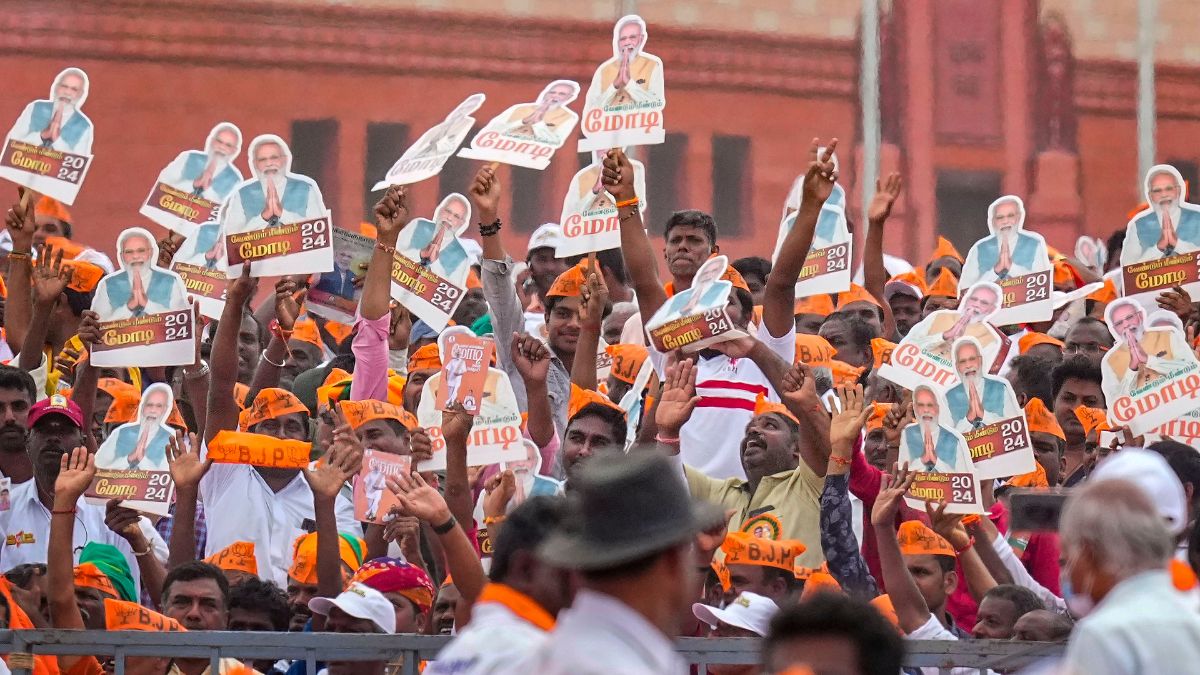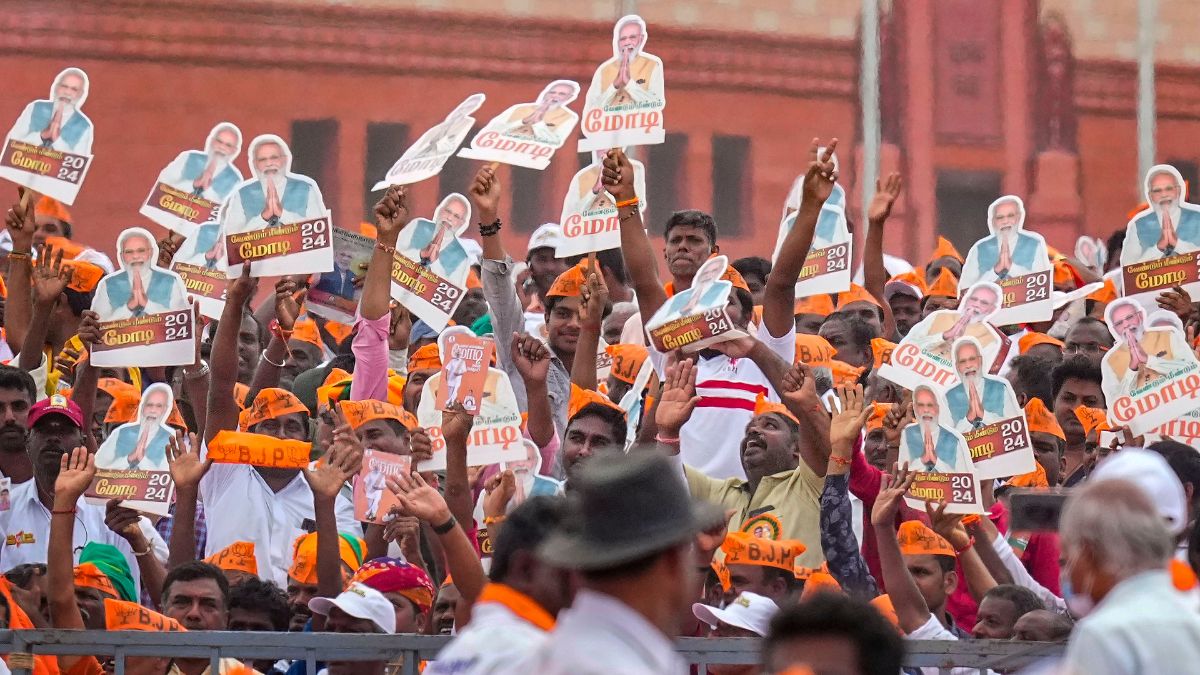Editor’s Note: A network of 60 reporters set off across India to test the idea of development as it is experienced on the ground. Their brief: Use your mobile phone to record the impact of 120 key policy decisions on everyday life; what works, what doesn’t and why; what can be done better and what should be done differently. Their findings — straight and raw from the ground — will be combined in this series, Elections on the Go_, over a course of 100 days._
Read more articles from the series here
***
Ganderbal: Mohammad Afzal Bhat (60) from Watlar village was lucky, like most apple growers in the Ganderbal constituency and across Kashmir, to have had time to harvest the year’s fruit, because days later, on 3 November, 2018, untimely snow wreaked havoc in the Valley, the likes of which hasn’t been seen there for nearly a decade. Bhat, however, couldn’t protect his orchard from the damage that, officials and experts say, has broken the backbone of the Valley’s apple growers, as several orchards have been ravaged.
After harvesting the fruit last October, Bhat was preparing for post apple-picking activities — pruning perennials, tilling surfaces around tree trunks, and removing invasive weeds — to protect his 20-kanal apple orchard from any possible damage, but heavy snowfall on 3 and 4 November forced all growers to stay put in their homes and watch their labour of love get destroyed — partial or full breakage of branches, trees uprooted, tree trunks shaken, and harvested and ready-to-be-sold fruit ruined. The ‘root rot’ and ‘collar rot’, caused when rainwater or snow accumulates around roots or trunks and leads to decay, also damaged many trees in the days that followed.
The Rs 7,000-crore horticulture industry, considered to be the Valley’s backbone, has 1,44,825 hectares under apple cultivation in Kashmir’s ten districts. Government records reveal the average annual apple production in the Valley is 17 lakh metric tons. Almost one-third of this was damaged. That is more than 43,353 hectares of apple orchards owned by 3.65 lakh families in over 2,350 villages and towns in the Valley have been affected.
Picking up the pieces
Chief Horticulture Officer, Ganderbal, Shabir Ahmad Mattu says 106-odd hectares of apple orchards owned by 4,094 families in around 65 villages were affected — this is 36 percent of the constituency’s overall apple production area. But 50 percent of the affected orchard owners have been compensated with Rs 4,000 under the State Disaster Response Fund (SDRF), and the rest will be compensated soon in a phased manner, he adds.
An irate grower, however, retorts, “An average apple tree gives a harvest worth Rs 5,000 every year. So you can see that the compensation announced doesn’t even cover one tree. How’s this justified?”
Of Bhat’s 500 apple trees, more than 150 have suffered minor to heavy damage. “A few trees are completely uprooted. All that’s left to do of them now is to burn them for fuel during winters,” he rues, angry at the government for leaving the growers to fend for themselves. “Nobody has approached us to help us through this devastation, neither have we received any compensation from the government, which continues to claim that it has already dispensed it,” adds Bhat, walking through his devastated orchard and mournfully picking up broken branches.
Other farmers from the constituency have pegged their losses at between Rs 30,000 and Rs 50,000. “It’s hard for us (growers) to ascertain the damage in numbers. Limb breakage was the common denominator across orchards. We clipped the damaged branches and saved the trees. But this will have a direct bearing on apple production in our village as well as across Kashmir. As per my calculation, I will have to bear an annual loss of Rs 70,000 for at least the next three years,” says Aabid Hussain, an orchardist from Lar, Ganderbal. Those trees with extensive branch damage would have to be cut completely and replaced with new ones.
“More than 15 apple trees have been damaged in my 12-kanal orchard. An average apple tree takes 8 to 12 years to grow fully; so the fact that I have to replace three with new ones means that I have to wait for 10 years and, simultaneously, invest in other resources to improve yield. All this will bring my losses to nearly Rs 2 lakh. In my village, Wakoora, average damage is between Rs 50,000 and Rs 1 lakh. So, the compensation offered by the government is peanuts,” says Mohammad Ashraf, an orchardist.
Traversing from village to village, going from door to door, the story remains the same — in the absence of any unions or associations for Ganderbal’s orchardists, the growers have been left out in the cold, while government officials continue to downplay the damage sustained and losses incurred, because there reportedly aren’t enough funds to compensate everyone affected.
Where were the elected representatives?
For Abid Hussain (28) from Watlar village, it’s the absence of a representative whom, he says, they had chosen during the previous election to address their grievances, is what’s astonishing. “We haven’t seen him here since the snow unleashed its fury. If he can’t redress our grievances or hear our distressed calls, we better replace him with someone else in the upcoming election,” he says; Hussain is referring to the local MLA of National Conference (NC), Ishfaq Ahmad Shaikh, who won the last election for his pro-farmer promises.
Ganderlbal resident Arif Lone seconds Hussain and says the local MLA didn’t show up despite so many farmers being distressed.
Shaikh, however, claims to have visited several snow-ravaged areas and promises to make a case of reasonable compensation for orchardists in his constituency once a popular government is in power.“The compensation announced under State Disaster Response Fund (SDRF) is peanuts. The massive damage demands a reasonable compensation, for which I will fight after I am chosen as a representative once again,” says Shaikh, who hopes to win the upcoming election as well.
Given the calls by pro-freedom groups like Hurriyat for boycott of all elections, most parts of the Valley witness minuscule voting in both Assembly and Lok Sabha elections. However, Ganderbal is among the few constituencies that has seen a higher voter turnout. Local issues like road connectivity, health facilities, and agricultural and horticultural development play an important role in deciding the fate of legislators in the fray. The constituency has been dominated by NC both at the Lok Sabha and Vidhan Sabha levels. With livelihoods of a majority dependent on horticulture, a sizeable number of voters will seek the region’s development in the form of new plans and execution of already laid out policies from legislators contesting in the upcoming elections.
Assessing the damage
Deputy Director of Horticulture, Kashmir, Mohammad Yousuf Dar says the damage happened because the ‘leaf fall’ was yet to occur and the pruning activity yet to begin. “Though we usually issue advisories when there is an early snowfall prediction, we didn’t predict or expect such a massive snowfall. Snow accumulated on tree branches, which caused them to bend and break from the weight,” he adds. The government estimates losses due to this damage to trees along with horticulture and agricultural crops at Rs 500 crore. Apple growers’ associations across the Valley, however, say the loss is double that figure — Rs 1, 000 crore and that too only for apple fruits and orchards.
Figures available with the Department of Horticulture, Kashmir, reveal that in terms of area, Kulgam district in south Kashmir is the worst-hit with 9, 945 hectares damaged, followed by Kupwara, Shopian, Anantnag, Bandipora, and Pulwama with 8,823, 6,948, 6,047, 4,571, and 3,488 hectares affected, respectively. In terms of overall apple production, Pulwama district tops with 45 percent of its apple crop and fruit damaged. It’s followed by Baramulla in the north, Kulgam in the south, and Ganderbal in central Kashmir with 42 percent, 37 percent, and 36 percent, respectively. Kupwara’s damage is 34 percent, and Shopian and Anantnag’s 33 percent each.
The lack of insurance coverage for orchards has further distressed the farmers. Growers across Watlar, Choontwar, Waliwar, Benhama, Baghe-e-Zaman, Arhama, Bagh-e-Manandh, Yaarmuqam, Repora, Bala, Wakoora, Dab, Sherbagh, Wakoora, and surrounding villages in Ganderbal, who we met, rued their harvest’s vulnerability to natural calamities and the absence of insurance protection for the same to mitigate the losses. Many of them, like Manzoor Ahmad from Wakoora village, have urged the government to bring apple growers under the umbrella of insurance.
Experts explain HDP model and farmers’ hesitation
Associate Director (Research Wing) at Sher-e-Kashmir University of Agricultural Sciences, Kashmir (SKUAST-K), Professor Muhammad Saleem Mir rules out any impact of climate change on the horticulture sector in the region and attributes the aberration in weather conditions as a natural phenomenon that occurs after long internals and irregularly.
Switching over to High-Density Plantation (HDP) entirely is what, the government and experts say, will protect the crop from unforeseen natural calamities due to erratic weather. An HDP orchard is organised in such a way that there is little to no effect of snowfall, hail, and windstorms on the crop. And while it takes an apple tree around eight to 12 years to yield the fruit, High-Density Plants yield the fruit in just two or three years.
Government officials claim that they, along with scientists, have been going from door to door to encourage more farmers to adopt this model. “The damage caused could have been avoided had farmers followed the techniques already provided to them by agricultural experts,” says Mir. “An HDP orchard is well protected from natural calamities and gives a better and higher yield. It also involves less expenditure and minimises chances of huge quantities of the fruit getting spoiled.”
Though farmers in European nations switched to HDP decades ago, it remains a new and unexplored concept in the Valley. There is a lack of knowledge and awareness among Kashmir’s farmers about it, and that’s the main reason why they have been giving it the cold shoulder. Experts, however, say the situation is changing gradually. Farmers are approaching officials and experts for guidance on planting high-density crops in their orchards. The affected growers concede that they will replace most of the damaged trees with HDP ones.
(The author is a Srinagar-based freelance writer and a member of 101Reporters.com )


)




)
)
)
)
)
)
)
)